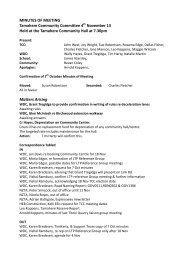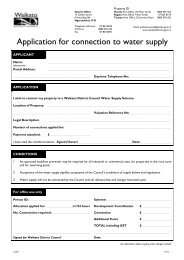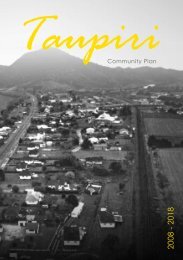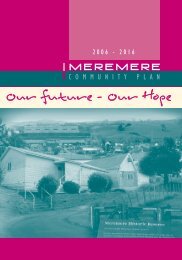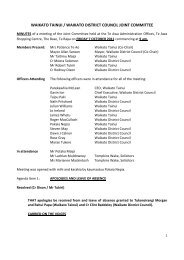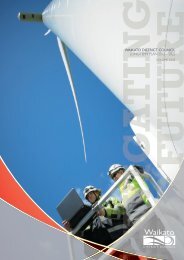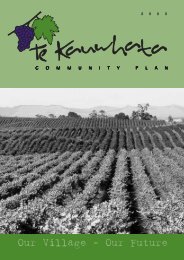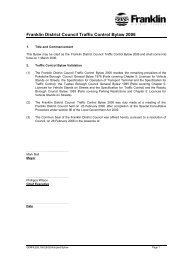1.2 Purpose of this waste assessment - Waikato District Council
1.2 Purpose of this waste assessment - Waikato District Council
1.2 Purpose of this waste assessment - Waikato District Council
- No tags were found...
Create successful ePaper yourself
Turn your PDF publications into a flip-book with our unique Google optimized e-Paper software.
7.0 Statement <strong>of</strong>options7.1 Addressing demandThe areas <strong>of</strong> demand have been identified in sections 6.2.1 to 6.2.7. In the sections below, options foraddressing the areas <strong>of</strong> demand are outlined and the potential role for council discussed.7.1.1 Data and monitoringMore reliable data and monitoring <strong>of</strong> <strong>waste</strong> in the district will make it easier for the council to deliver itsstrategic <strong>waste</strong> management responsibilities as set out in the WMA. The council is also the best placed agencyto deliver data collection and monitoring through its ability to pass a bylaw that requires <strong>waste</strong> operators toprovide information.The council should take a lead agency role in <strong>this</strong> area as they require the information for <strong>waste</strong> management,and has the tools to require that the information be provided.At present there is limited ability for the council to access data outside <strong>of</strong> council controlled <strong>waste</strong> streams.Accessing <strong>this</strong> data may require a licensing regime to be established.7.<strong>1.2</strong> RegulationThe regulatory tool predominantly used by local authorities to manage <strong>waste</strong> is the bylaw.A <strong>waste</strong> bylaw could simply require <strong>waste</strong> operators to provide information, as discussed above, or morestringent requirements could be put in place such as compulsory recycling, separating <strong>waste</strong> streams forrecycling, extended litter and illegal dumping controls, and control <strong>of</strong> cleanfills.The community’s view on the extent <strong>of</strong> a <strong>waste</strong> bylaw should be assessed through the WMMP consultationprocess by proposing a range <strong>of</strong> areas which could be addressed through a bylaw. However the council shouldalso agree a minimum level <strong>of</strong> control they wish to achieve through a bylaw. The bylaw previously in place inthe Franklin district, which addresses definitions, receptacles, <strong>waste</strong> placement, collection arrangements, illegaldumping and litter, and licensing could be used as a minimum guideline. A regulatory approach could also beused to encourage or require businesses to manage their <strong>waste</strong> better, although better data and monitoringwould probably be required before <strong>this</strong> step could be taken.The council will need to take a lead agency role in <strong>this</strong> area as they are the only agency with the necessarypowers.It is worthwhile emphasising the potential impact <strong>of</strong> neighbouring areas on the need to introduce regulationand enforcement. This is particularly the case with regard to cleanfills. Auckland <strong>Council</strong>’s <strong>waste</strong> <strong>assessment</strong>includes a proposal to introduce a bylaw regulating cleanfills. If <strong>this</strong> is implemented it could precipitate themigration <strong>of</strong> significant quantities <strong>of</strong> material out <strong>of</strong> Auckland – in particular material that does not fit thedefinition <strong>of</strong> cleanfill material under the potential bylaw. In other words such a move could result in theuncontrolled disposal <strong>of</strong> large quantities <strong>of</strong> potentially harmful material into the <strong>Waikato</strong> district. It wouldtherefor, be prudent to monitor the situation in surrounding areas and ensure that regulations and enforcementare at least comparable to neighbouring districts.7.1.3 Waste streamsA significant amount <strong>of</strong> <strong>waste</strong> could be diverted from landfill by introducing new collections, altering existingcollection services, and enhancing separation <strong>of</strong> materials at transfer stations. Waste streams that have potentialfor enhanced diversion include:• Food <strong>waste</strong>42



